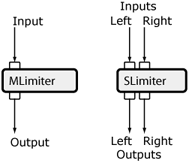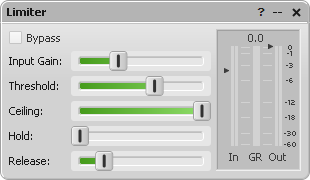| AudioMulch Help > Contraption Reference > Dynamics | Previous Next |
*Limiter
Limits the peak level of a sound to avoid harsh clipping distortion.

MLimiter and SLimiter are mono and stereo peak limiters. A limiter prevents the peak level of an input signal from exceeding a threshold level. MLimiter and SLimiter provide parameters for setting the maximum input level and output level, and parameters for controlling how quickly the limiter recovers after limiting has been applied.
 |
See the Adjusting Contraption Properties section for information about using sliders, knobs, presets etc. |
Related Contraptions
Parameters

|
Bypass |
When enabled, passes the unprocessed input through to the output. |
|
Input Gain (InputGain) |
Adjusts the gain of the input sound before limiting is applied. |
|
Threshold |
Specifies the maximum allowable input level. Input above this level is limited. |
|
Ceiling |
Specifies the resulting maximum output level. |
|
Hold (HoldTime) |
Adjusts the time the limiter will maintain gain reduction. This can be useful for reducing distortion when limiting low frequency sounds. |
|
Release (ReleaseTime) |
Adjusts the speed with which the limiter recovers after limiting a peak. |
Instructions
Meters
Limiter provides a number of meters to allow you to monitor its operation.
The Input (In), Gain Reduction (GR) and Output (Out) meters use the same scale. It is a stretched scale which makes it easier to see the top 12dB, which are usually of the most interest.
From left to right:
The Input meter (In) displays the level of the incoming signal after Input Gain has been applied. The Threshold level is indicated by an arrow at the side of the meter.
The Gain Reduction meter (GR) indicates how much gain reduction is being applied by the Limiter.
The Ouput meter (Out) shows the output level. The Ceiling is indicated by an arrow at the side of the meter.
Technical Discussion
Limiter uses a "lookahead" algorithm. This employs a fixed 64-sample lookahead buffer so that it can preempt rapid transients. As a result, all signals passed through this contraption are delayed by 64 samples.
| Previous Next |
